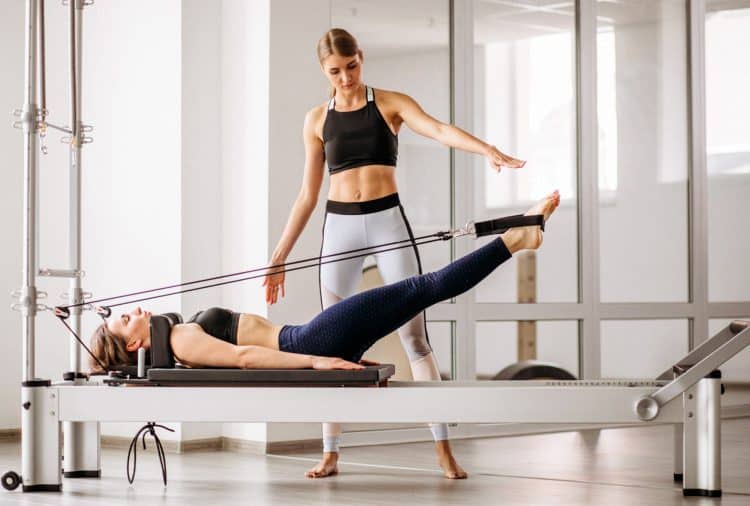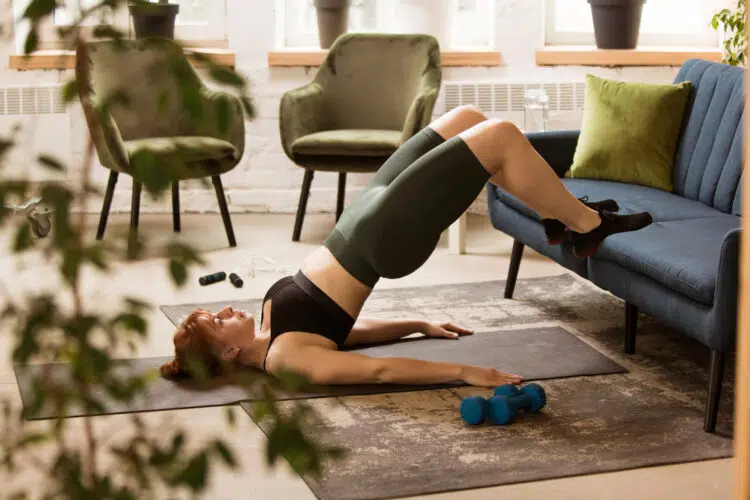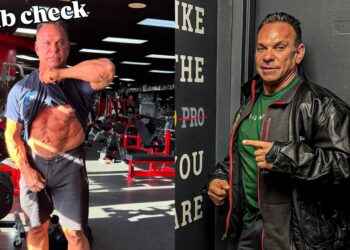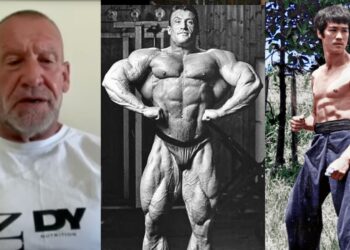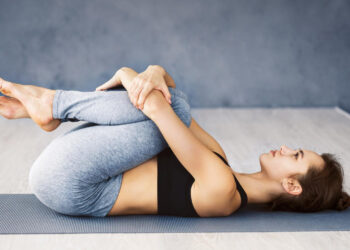Strength training is one of the most versatile and rewarding forms of exercise around, and it’s no exaggeration to say that it’s good for everybody’s body. However, as a veteran personal trainer, I also understand that some people don’t want to lift weights.
They find all those clanking plates and machines intimidating. Or, they prefer to work out at home and don’t have space for lots of bulky equipment.
Either way, despite the obvious benefits of strength training, some people find it a turn-off.
The good news is that you don’t have to lift weights to enjoy many of the benefits of strength training and research tells us that bodyweight exercises can be just as effective (1).
That’s because, in simple terms, your body has no way of knowing whether you are lifting a barbell, dumbbells, etc., or working against your own resistance. Providing you exercise consistently and with sufficient intensity, your muscles will respond and adapt to your workouts.
There are several types of bodyweight training, including classic calisthenics, yoga, and Pilates. While each one is slightly different, they all work in much the same way.
Level Up Your Fitness: Join our 💪 strong community in Fitness Volt Newsletter. Get daily inspiration, expert-backed workouts, nutrition tips, the latest in strength sports, and the support you need to reach your goals. Subscribe for free!
In this article, I share a 30-minute Pilates-inspired workout for your abs and hips.
What is Pilates?
Pilates has been around since the early 1920s and was invented by German physical culturist Joseph Pilates. Pilates was reportedly a sickly child but was determined not to be a weak, unhealthy adult. He created his exercise program to improve his body and mind, and it soon became a global fitness phenomenon.
Initially, the Pilates method revolved around the use of special machines called reformers. However, Pilates also developed a range of bodyweight exercises to complement his machine-based workouts. These exercises are often known as mat-based Pilates.
Many Pilates exercises have since entered mainstream fitness. For example, the ever-popular plank and glute bridge were originally Pilates exercises.
The Pilates Principles
Pilates system is based on six principles: Centering, Concentration, Control, Precision, Breath, and Flow. Apply these fundamentals to every Pilates exercise to make it more effective:
- Centering: This is the term used in Pilates to describe how exercisers should focus on their core during training. Pilates called the core the body’s powerhouse. It’s essentially the space between your lower ribs and pelvis.
- Concentration: Exercisers should focus their awareness and attention on the muscles they are working to obtain maximum value from each and every movement. Modern exercisers know this as the mind-muscle connection.
- Control: Each exercise in Pilates should be performed purposefully and with control. No movements should happen by accident.
- Precision: Every exercise must be done in a very specific way. There is a predetermined limb position, joint alignment, and movement path for each body part.
- Breath: Most Pilates exercises involve controlled breathing, and movements are often done for a set number of breaths. Deep, full breaths are a big part of Pilates.
- Flow: Fluidity and grace are hallmarks of Pilates. Exercises are never hurried, done jerkily, or by using muscles not supposed to be involved in a particular exercise. You should end your set if you are unable to continue in perfect form.
The Benefits of Pilates Include:
Is Pilates worth your time and energy? Consider these benefits and then decide!
Increased muscle strength – like conventional strength training, Pilates overloads your muscles and as such, will make you stronger. However, that overload comes from high reps rather than heavy weights.
Increased muscular endurance – high-rep Pilates exercises will make your muscles more resistant to fatigue. Consequently, you be able to perform many physical activities for longer and without getting tired.
Increased core strength – almost every Pilates exercise starts by engaging your core. Core is the collective term for the muscles that make up your midsection. So, even if you aren’t doing a Pilates abs exercise, your midsection will be working. A stronger core can help reduce and prevent back pain (2).
Better posture – prolonged sitting, slouching, and sedentarism mean that lots of people suffer from poor posture. Poor posture affects not only how you look, but also how you feel and function. For example, poor posture is a leading cause of back pain.
Pilates improves posture by targeting your deep stabilizers and core muscles. Better posture can help prevent and treat back and neck pain and also make you look slimmer and younger. Sitting and standing tall makes you look and feel more confident, too.
Level Up Your Fitness: Join our 💪 strong community in Fitness Volt Newsletter. Get daily inspiration, expert-backed workouts, nutrition tips, the latest in strength sports, and the support you need to reach your goals. Subscribe for free!
Better balance, stability, and coordination – with its emphasis on posture and limb correct position, Pilates works your nervous system as much as your muscles. Learning to control your limbs so precisely will improve balance, stability, and coordination, which will have a positive effect on how you move.
Improved mind-muscle connection – Pilates places a lot of emphasis on feeling the right muscles working as you exercise. Developing your mind-muscle connection will make all of your workouts more effective.
In summary, Pilates is a very rewarding and worthwhile exercise system. While it won’t make you bodybuilder-big or powerlifter-strong, it will improve your functional fitness and health. In short, it’s a viable alternative to strength training for anyone who doesn’t want to lift weights.
30-Minute Pilates Abs and Hips Workout
Tone your abs and hips at home with this tried and tested 30-minute Pilates-inspired workout. Do it 3-4 times per week for best results.
But, before you begin, make sure you spend a few minutes preparing your muscles and joints with an appropriate warm-up. For example, do 5-10 minutes of easy cardio to get your blood pumping followed by dynamic mobility and flexibility exercises for your knees, hips, and lower back.
Warmed up and ready to go? Then let’s get to work!
| Exercise | Beginner | Intermediate | Advanced | |
| 1 | Bear Drop and Hold | 2 x 8-10 reps | 3 x 10-12 reps | 4 x 12-15 reps |
| 2 | Shoulder Bridge Spine Curl | 2 x 6-8 reps | 3 x 8-10 reps | 4 x 10-12 reps |
| 3 | Pilates Hundred | 1 x 100 reps | 2 x 100 reps | 3 x 100 reps |
| 4 | Pilates Swimmer | 2 x 8-10 reps | 3 x 10-12 reps | 4 x 12-15 reps |
| 5 | Front and Back Side Kick | 2 x 10-12 | 3 x 12-15 | 4 x 15-20 |
1. Bear Drop and Hold
This exercise will wake up your entire body and prepare your core for the more demanding exercises that follow. Like all Pilates movements, it’s a deceptively challenging exercise that looks easier than it really is! You’ll also feel this exercise in your arms, shoulders, chest, and legs.
Steps:
- Adopt a kneeling quadruped position with your knees directly below your hips and your hands beneath your shoulders. Press your palms and the balls of your feet into the floor and extend your neck.
- Engage your abs.
- Inhale and lift your knees a couple of inches off the floor.
- Exhale and lower your knees back to the floor.
- Continue for the prescribed number of reps and sets.
2. Shoulder Bridge Spine Curl
The Pilates shoulder bridge spine curl is a very precise glute, leg, lower back, and core exercise. It links your movements to your breathing, which increases that all-important mind-muscle connection. Don’t let the lack of external weight fool you; this is still a very effective booty-builder.
Steps:
- Lie on your back with your legs bent and feet flat on the floor.
- Press your lower back into your mat, flatten your lumbar spine, and engage your abs.
- Inhale and, moving one vertebra at a time, lift your back off the floor until your weight is supported on your feet and shoulders only.
- Pause for a slow count of three.
- Exhale, unwind your spine, and return to the starting position.
- Continue for the prescribed number of reps and sets.
3. The Pilates Hundred
The hundred is a classic Pilates abs exercise. In addition to working your core muscles, it also provides a welcome workout for the muscles on the front of your thighs and hips. As the name implies, you are meant to do 100 reps of this exercise. However, if that’s too much for you, feel free to do 30, 50, or 70 reps, working up to the full 100 over several weeks or months.
Steps:
- Lie on your back and engage your abs.
- Press your lower back into the floor and lift your legs so they’re straight and at a 45-degree angle.
- Extend your arms so they’re palms down next to your hips.
- Inhale and pump your arms up and down five times.
- Exhale and pump your arms up and down five times.
- Repeat this sequence 10 times to do 100 arm pumps (or adjust as necessary).
- Rest and repeat for the prescribed number of sets.
4. Pilates Swimming
Most people think of swimming as a cardio workout but, Pilates-style, it’s a great way to work your glutes and lower back. In addition, Pilates swimming provides a useful posture-enhancing upper back workout while gently stretching your abdominals and chest. As such, this is an excellent exercise for enhancing posture.
Steps:
- Lie on your front with your arms and legs straight.
- Press your hips into the floor and lift your hands and feet a few inches off the ground. Raise your head slightly to look forward and not down.
- Keeping your hips grounded, raise your left arm and right leg a few additional inches.
- Next, lower your left arm/right leg and raise the opposite limbs.
- Inhale for four kicks and exhale for four kicks.
- Four kicks are one repetition.
- Continue for the prescribed number of reps and sets.
5. Front and Back Side Kick
The final exercise trains your core, hips, and legs at the same time, making it a very comprehensive way to end your 30-minute Pilates workout. The key to this exercise is moving slowly and deliberately. Rapid movements create momentum, which will take work away from the target muscles. Slower movements are harder, but far more effective.
Steps:
- Lie on your side with your legs straight and together. Rest your head on one hand and place your other hand on the floor in front of you.
- Engage your abs and make sure your hips and shoulders are square.
- Lift your uppermost foot about 12 inches off the floor so it’s about hip height.
- Keeping your leg straight and your foot level with your hip, swing your foot forward as far as your hamstring flexibility allows and then as far back as you can without extending your lower back.
- Inhale as your leg moves forward, and exhale as you swing it back.
- Make sure your pelvis remains stationary throughout.
- Continue for the prescribed number of reps and sets.
Closing Thoughts
You don’t need to lift weights to strengthen and tone your muscles. In fact, you can get in great shape using nothing more than your own body weight for resistance.
Of course, if you want to get big like a bodybuilder or strong like a weightlifter, you’ll need more than calisthenics or Pilates to develop your muscles. But, for many exercisers, bodyweight workouts like yoga, calisthenics, and Pilates will provide the results you want without having to go to a gym.
Related: Home Workouts vs. Gym Sessions: What’s Best For Your New Year Goals?
References:
- Kotarsky CJ, Christensen BK, Miller JS, Hackney KJ. Effect of Progressive Calisthenic Push-up Training on Muscle Strength and Thickness. J Strength Cond Res. 2018 Mar;32(3):651-659. doi: 10.1519/JSC.0000000000002345. PMID: 29466268.
- Kumar T, Kumar S, Nezamuddin M, Sharma VP. Efficacy of core muscle strengthening exercise in chronic low back pain patients. J Back Musculoskelet Rehabil. 2015;28(4):699-707. doi: 10.3233/BMR-140572. PMID: 25467999.

